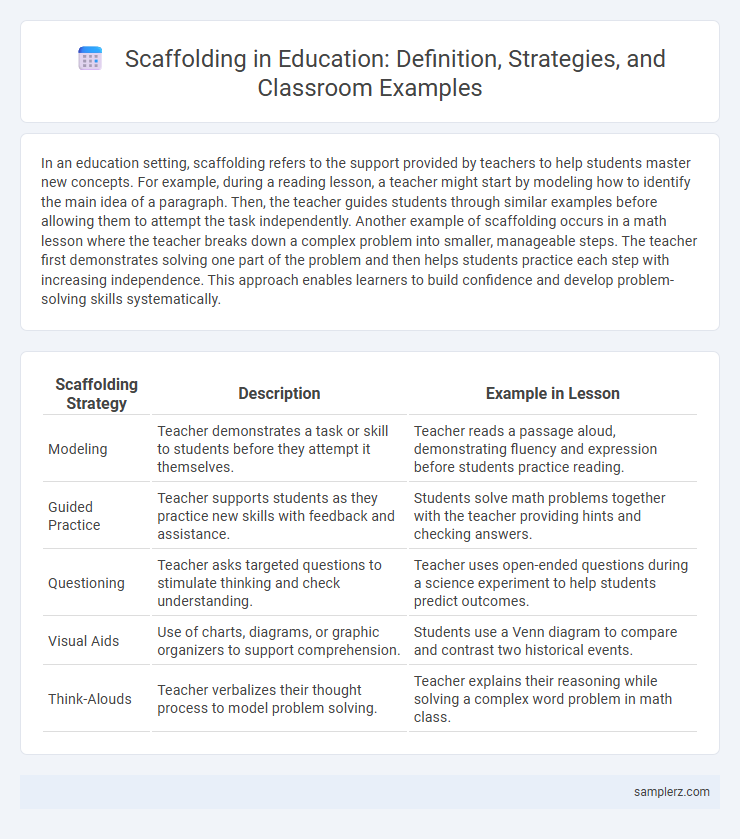In an education setting, scaffolding refers to the support provided by teachers to help students master new concepts. For example, during a reading lesson, a teacher might start by modeling how to identify the main idea of a paragraph. Then, the teacher guides students through similar examples before allowing them to attempt the task independently. Another example of scaffolding occurs in a math lesson where the teacher breaks down a complex problem into smaller, manageable steps. The teacher first demonstrates solving one part of the problem and then helps students practice each step with increasing independence. This approach enables learners to build confidence and develop problem-solving skills systematically.
Table of Comparison
| Scaffolding Strategy | Description | Example in Lesson |
|---|---|---|
| Modeling | Teacher demonstrates a task or skill to students before they attempt it themselves. | Teacher reads a passage aloud, demonstrating fluency and expression before students practice reading. |
| Guided Practice | Teacher supports students as they practice new skills with feedback and assistance. | Students solve math problems together with the teacher providing hints and checking answers. |
| Questioning | Teacher asks targeted questions to stimulate thinking and check understanding. | Teacher uses open-ended questions during a science experiment to help students predict outcomes. |
| Visual Aids | Use of charts, diagrams, or graphic organizers to support comprehension. | Students use a Venn diagram to compare and contrast two historical events. |
| Think-Alouds | Teacher verbalizes their thought process to model problem solving. | Teacher explains their reasoning while solving a complex word problem in math class. |
Introduction to Scaffolding in Education
Scaffolding in education involves providing structured support to students during the learning process, such as using guided questions and visual aids in an Introduction to Scaffolding lesson. Teachers progressively reduce assistance as learners gain confidence and mastery, enabling independent problem-solving. This method enhances comprehension and retention by breaking complex tasks into manageable steps and building on prior knowledge.
Types of Scaffolding Strategies in the Classroom
Modeling involves the teacher demonstrating a skill or concept step-by-step to guide student understanding, while questioning prompts critical thinking and helps students build knowledge independently. Visual scaffolding uses charts, graphic organizers, or images to support comprehension and memory retention during lessons. Collaborative scaffolding encourages peer interaction and shared problem-solving, allowing students to learn through social engagement and feedback.
Modeling Concepts: Teacher-Led Demonstrations
Teacher-led demonstrations exemplify scaffolding by visually modeling complex concepts, enabling students to observe and internalize problem-solving steps. In a math lesson, the teacher might solve a quadratic equation on the board, verbalizing each phase and decision, which guides learners through unfamiliar procedures. This approach reduces cognitive load and builds students' confidence before they attempt independent practice.
Using Think-Alouds to Guide Student Understanding
Using think-alouds in lessons involves teachers verbalizing their thought processes while solving problems or analyzing texts, which models critical thinking strategies for students. This scaffolding technique helps learners internalize metacognitive skills by making invisible reasoning explicit, fostering deeper comprehension and problem-solving abilities. Research shows that think-alouds improve students' ability to approach complex tasks independently by gradually transferring cognitive responsibility from teacher to student.
Graphic Organizers as Scaffolding Tools
Graphic organizers serve as effective scaffolding tools by visually structuring information to support students' comprehension and critical thinking in lessons. Examples include concept maps, Venn diagrams, and flow charts that help learners organize ideas, identify relationships, and sequence events. These tools enhance cognitive processing, making complex content more accessible and facilitating independent learning.
Questioning Techniques for Deeper Learning
Effective scaffolding in education employs questioning techniques that promote deeper learning by encouraging students to analyze, evaluate, and synthesize information. Open-ended questions such as "Why do you think this happened?" or "How would you compare these ideas?" guide learners to explore concepts beyond surface understanding. This approach fosters critical thinking and supports gradual skill development by prompting reflective and higher-order cognitive processes.
Peer Collaboration and Cooperative Learning
Peer collaboration and cooperative learning are effective scaffolding techniques in education that promote student engagement and deeper understanding. Students work together in small groups to solve problems, share ideas, and provide mutual support, which enhances critical thinking and communication skills. This collaborative scaffolding builds a supportive learning environment that gradually shifts responsibility from teacher to learners, fostering independence and confidence.
Guided Practice Before Independent Work
During guided practice before independent work, teachers provide structured support by modeling problem-solving steps and offering targeted questions that help students internalize concepts. This approach reinforces understanding through immediate feedback and collaborative discussion, ensuring students build confidence. Effective scaffolding gradually reduces assistance, preparing learners for autonomous application of skills.
Gradual Release of Responsibility Approach
The Gradual Release of Responsibility approach in education exemplifies scaffolding by initially providing explicit teacher modeling before transitioning to guided practice and independent student work. This method supports learners at each stage, gradually shifting accountability for comprehension and skill mastery from educator to student. Research shows that scaffolded lessons using this approach enhance student engagement and deeper understanding of complex concepts.
Real-World Applications of Scaffolding in Lessons
Scaffolding in education often involves breaking down complex real-world tasks into manageable steps, such as guiding students through a science experiment by first teaching key concepts and then gradually introducing hands-on activities. Another example is using project-based learning where educators provide structured support while students apply mathematical concepts to budget a fictional event. This approach helps learners connect theory to practical scenarios, enhancing comprehension and skill retention.

example of scaffolding in lesson Infographic
 samplerz.com
samplerz.com